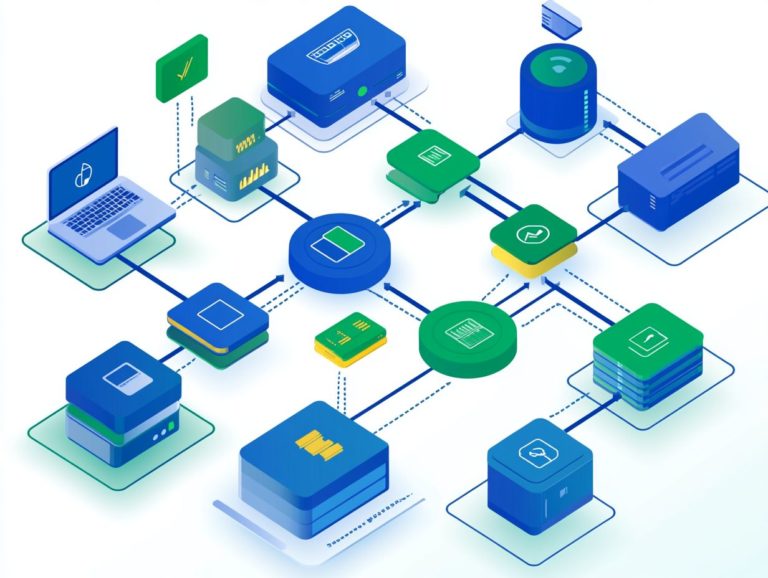Exploring Open Source PaaS Options
The realm of Platform as a Service (PaaS) is experiencing rapid evolution, presenting you with flexible and scalable solutions for your application development and deployment needs.
In this article, you ll explore the fundamentals of PaaS. You will uncover its numerous benefits and the key distinctions between open source and proprietary options. From popular platforms to essential selection criteria, you’ll find everything you need to make informed decisions.
The article covers best practices for implementation and emerging trends that are shaping the open source PaaS landscape.
Immerse yourself and discover how to harness PaaS to elevate your business to new heights!
Contents
- Key Takeaways:
- Understanding PaaS and Its Benefits
- Open Source PaaS vs. Proprietary PaaS
- Top Open Source PaaS Options
- How to Choose the Right Open Source PaaS
- Implementing and Managing Open Source PaaS
- Best Practices and Tips for Success
- Future of Open Source PaaS
- Trends and Predictions for the Industry
- Frequently Asked Questions
- What is an Open Source PaaS?
- What are some advantages of using Open Source PaaS options?
- What are some popular Open Source PaaS options?
- Are there any limitations to using Open Source PaaS options?
- What should I consider when exploring Open Source PaaS options?
- How can I get started with using an Open Source PaaS?
Key Takeaways:

Open source PaaS provides budget-friendly options with customizable features, perfect for any business! When deciding on an open source PaaS, consider factors such as scalability, security, and support to ensure it meets your business needs. The future of open source PaaS looks promising, with advancements in cloud technology and increasing demand for flexible and affordable options. Stay ahead by watching new trends and predictions shaping the industry!
Understanding PaaS and Its Benefits
Platform as a Service (PaaS) is a game-changing approach to cloud computing, giving you the power to build, deploy, and manage applications without grappling with the intricacies of underlying infrastructure management.
With a cohesive platform for application deployment, PaaS tools simplify the development process. This allows for quicker innovation and significantly shortens your time-to-market.
You can take advantage of custom PaaS solutions tailored precisely to your needs. This ensures smooth deployment across diverse cloud environments while enhancing your application management and automation capabilities.
Definition and Advantages of PaaS
Platform as a Service (PaaS) is your go-to cloud computing model that gives you the power to develop, run, and manage applications without the usual headaches of building and maintaining the underlying infrastructure associated with app development and launch.
This cloud-based solution streamlines the entire application lifecycle. You can focus on what truly matters: coding and innovation, rather than getting bogged down with hardware maintenance and software updates.
By embracing PaaS, you can significantly cut down on infrastructure costs. This frees up more of your budget for application development and marketing efforts.
The innate scalability of PaaS ensures that your applications grow effortlessly as your organization evolves.
With the power of DevOps a practice that combines software development and IT operations at your fingertips, you can manage deployments and updates with remarkable efficiency. This fosters a collaborative environment that accelerates development cycles and boosts overall productivity in cloud settings.
Open Source PaaS vs. Proprietary PaaS
The discussion surrounding Open Source PaaS versus Proprietary PaaS centers on key elements like flexibility, customization, and control.
With Open Source tools, you gain the ability to modify and tailor your solutions to fit specific requirements seamlessly. On the other hand, proprietary options often deliver a more polished user experience, accompanied by dedicated support.
Your choice affects how you develop and deploy your projects.
Comparison of Features and Costs
When you compare Open Source PaaS with Proprietary PaaS, several factors come into play, such as core features, multi-cloud support, and the overall costs tied to deployment and maintenance.
It s crucial for you to consider the specific characteristics and strengths of each model. Open Source PaaS often fosters a collaborative atmosphere, encouraging customization and flexibility. This can spark innovation but may also demand a higher level of technical expertise for effective management.
Conversely, Proprietary PaaS solutions offer a more streamlined and user-friendly experience. They are often backed by robust customer support. However, this convenience usually comes with higher license fees and less adaptability.
The choice you make between the two will not only affect the efficiency of application deployment but also influence your long-term financial commitments, especially as you scale operations or integrate multiple cloud environments.
Top Open Source PaaS Options

The landscape of Open Source PaaS options is rich and diverse. It showcases strong platforms like Cloud Foundry, Dokku, Qovery, CapRover, and Coherence, especially when considering integrating PaaS with other cloud solutions.
Each of these platforms has unique advantages tailored for developers seeking customizable solutions to meet specific needs.
Overview of Popular Platforms
Popular open-source PaaS platforms like Cloud Foundry, Dokku, Qovery, CapRover, and Coherence offer powerful tools for application deployment and management. Each platform brings distinct strengths to the table.
These platforms improve your development process. They offer streamlined deployment and user-friendly interfaces suitable for both novices and seasoned developers.
Take Cloud Foundry, for instance. It excels in scalability and supports microservices architecture (a way to build applications using small, independent components), making it a top choice for enterprises deploying complex applications.
Dokku offers a lightweight solution that allows you to deploy apps with minimal configuration. It also has a vibrant community contributing various plugins to enhance functionality.
Qovery shines with its automation features and seamless integration with popular version control systems. This ensures a smooth workflow for collaborative development.
CapRover makes things easy with its straightforward setup process and one-click app deployment. It s perfect for those who appreciate simplicity.
Meanwhile, Coherence stands out for its excellent support for stateful applications. With Coherence, you can tackle stateful applications effortlessly!
How to Choose the Right Open Source PaaS
Selecting the ideal Open Source PaaS requires careful evaluation of several key factors.
Consider your business needs, the level of customization you desire, and the specific capabilities offered by the available platforms, such as container orchestration (managing multiple containers as a single system) and Git integration.
This thoughtful approach will help you find a solution perfectly aligned with your objectives.
Factors to Consider for Your Business Needs
When evaluating Open Source PaaS solutions, consider factors like customizability, application management capabilities, and how well the platform aligns with your DevOps automation strategies, as outlined in navigating PaaS ecosystems.
These elements are crucial because they directly impact the platform’s ability to adapt to your operational needs. They also ensure seamless connection with your existing workflows.
Customizability enables teams to tailor the PaaS to their unique processes, leading to enhanced efficiency and optimal resource utilization.
Strong application management capabilities ensure that deployment, scaling, and monitoring occur without a hitch. This is essential for maintaining service quality and peak performance.
By ensuring that the platform is in sync with your company’s DevOps strategies, you cultivate improved collaboration between development and operations teams. This ultimately boosts productivity and speeds up the delivery of applications to market.
Implementing and Managing Open Source PaaS
Effectively implementing and managing an Open Source PaaS demands a well-defined strategy. This encompasses not only application deployment processes but also robust monitoring capabilities and efficient server management practices specifically designed for containerized applications.
By honing in on these elements, you can ensure a seamless experience and optimal performance in your environment.
Explore these platforms further, and consider trying them out to see which best fits your needs!
Best Practices and Tips for Success

Want to succeed with Open Source PaaS? Follow these best practices!
Adhere to best practices surrounding application deployment, leverage robust monitoring capabilities, and easily combine DevOps automation tools.
This approach not only boosts the efficiency of your development cycle. It also fosters a proactive mindset essential for tackling potential performance issues before they escalate.
By using real-time analytics and logging features, your team can gain invaluable insights into application behavior. This gives you the power to make informed decisions and execute timely optimizations.
Encouraging teamwork between development and operations teams through continuous integration and continuous delivery (CI/CD) practices will ensure that each deployment flows smoothly and predictably.
These strategies highlight the importance of ongoing assessment and adjustment. This ultimately leads to superior management and performance of your applications in the ever-evolving tech landscape.
Future of Open Source PaaS
The future of Open Source PaaS is on the brink of remarkable innovation, fueled by trends like advanced container orchestration capabilities and improved multi-cloud support.
This evolution gives you the power to customize your application environments with greater precision and adaptability.
Trends and Predictions for the Industry
Key trends are shaping the future of Open Source PaaS, and you should pay attention to them. Multi-cloud support is on the rise, container orchestration is advancing, and there s a heightened focus on enhancing the developer experience.
These changes indicate a significant shift toward more integrated and flexible cloud environments. Organizations like yours can harness the benefits of various platforms while sidestepping the pitfalls of vendor lock-in.
The evolution of container orchestration tools, such as Kubernetes, streamlines application deployment and management. This boosts both scalability and resilience.
As a result, you may find that adopting Open Source PaaS solutions becomes increasingly accessible. This fosters innovation and agility within your business.
With an intensified emphasis on the developer experience, tools and resources are evolving to facilitate swifter development cycles. This ultimately transforms how your teams collaborate and deliver value.
Frequently Asked Questions
What is an Open Source PaaS?
An Open Source PaaS, or Platform as a Service, is a cloud computing model that provides a platform for developers to build, manage, and deploy applications without the need for managing underlying infrastructure.
What are some advantages of using Open Source PaaS options?

There are several advantages to using Open Source PaaS options, such as cost savings, flexibility, scalability, and a wide range of development tools and frameworks to choose from.
What are some popular Open Source PaaS options?
Some of the popular Open Source PaaS options include Cloud Foundry, OpenShift, Kubernetes, and Heroku. These platforms offer various features and tools for developers to build and deploy their applications.
Are there any limitations to using Open Source PaaS options?
While Open Source PaaS options offer many benefits, they may have certain limitations such as limited control over infrastructure, potential compatibility issues with specific frameworks and tools, and the need for technical expertise to manage the platform.
What should I consider when exploring Open Source PaaS options?
When exploring Open Source PaaS options, it is important to consider factors such as the platform’s features and tools, compatibility with your project’s requirements, pricing and cost structure, and support and community resources available.
How can I get started with using an Open Source PaaS?
To get started with using an Open Source PaaS, you can research and compare different options. Additionally, understanding how to select the right PaaS provider can be beneficial. Sign up for a free trial or demo, and consult with experts or community members for guidance and best practices.
It is also important to thoroughly understand the platform’s documentation and support resources before beginning development.






